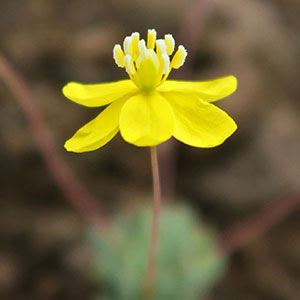Canbya aurea
Canbya candida
golden canbya, golden pygmypoppy, yellow pygmy-poppy
pygmy poppy, white pygmy-poppy
3-10 mm.
5-9 mm.
peduncle 1-6 cm.
peduncle 1-2 cm.
sepals 2 mm;
petals deciduous, 6, bright yellow, broadly ovate, 3-4 mm;
stamens 6-15;
filaments longer than anthers.
sepals 2 mm;
petals marcescent, 5-7, white, elliptic, 3-4 mm;
stamens 6-9;
filaments shorter than anthers.
2-4 mm.
1.5-2.5 mm.
= 16.
= 16.
Canbya aurea
Canbya candida
NV; OR
CA
Of conservation concern.
Canbya candida has been found only in the western Mojave Desert.
(Discussion copyrighted by Flora of North America; reprinted with permission.)


